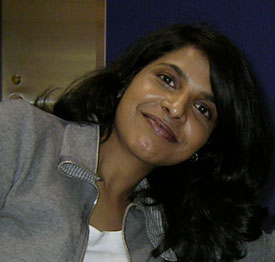Modeling Disease Outbreaks by Modeling Human Mobility
By Karthika Swamy Cohen
One of the primary ways a communicable disease spreads in a population is through human mobility networks. Control and elimination of disease can hence be accomplished by analyzing human movement.
At the SIAM Conference on Computational Science and Engineering being held in Atlanta, GA this week, Kyle Gustafson talked about modeling Ebola outbreaks by modeling human mobility, as part of a minisymposium on Data-Driven Characterization, Control, and Uncertainty Quantification of Dynamical Systems. The work was performed in collaboration with Joshua L. Proctor at the Institute for Disease Modeling.
"We want to model outbreaks, but we don't exactly know how people move," Gustafson said. "How do you model human mobility?"
He went on to explain the methods already in place for modeling movement. One of the most popular models is the gravity type model, which inevitably shows more movement as the population size increases.
Depiction of the 2014 Ebola outbreak in the West African countries of Guinea, Liberia, and Sierra Leone. Image courtesy of Wikimedia.
Gustafson then described a modified gravity model called the radiation model. He talked about comparisons between random walks and gravity models.
Random walks can have many difference step sizes: in the diffusion type, step sizes come from a random distribution. The Lévy flight, on the other hand, is a heavy-tailed random walk.
A Lévy flight, which can be described by a space fractional diffusion equation, has been used, for instance, to describe how Americans move and spend dollars etc.
Gustafson used a comprehensive data set already available on the Ebola outbreak, which depicted Ebola genomes in West Africa in 2014-2015. He reinforced the importance of open data in such cases, the available dataset being really advantageous.
The map showed genome sequences taken from the 14 districts in Sierra Leone - plotting the data confirmed Ebola cases and sequenced cases tracked the course of all cases. Most cases were seen to occur in Sierra Leone's capital city, Freetown, since it has a very high population.
Stage 1 of the epidemic showed fewer cases; the largest number of cases occurred early in stage 2, before dropping back in stage 3, when the surge of interventions reduced the number of cases. This sort of dynamics can be described by a Lévy flight model.
The factors to consider while modeling mobility are that it is a stochastic process, human behavior is dynamic, and the population landscape is inhomogenous. Non-diffusive, heavy-tailed transport models work well in this case.
An algorithm for sparsity sampling transmission chain was used to fir Ebola cases. Out of 1,000 genomes of Ebola outbreaks, the Partially Observed Transmission Chain (POTN) was able to fit 800 cases. The researchers then fit a Lévy flight model to transmission differences from the POTN.
The analysis revealed that early Ebola cases avoided Freetown. Once the disease progressed to Freetown, most cases occurred in Freetown. This is because population and mobility influence transmission.
Tracking the Ebola virus by modeling human mobility could help better control the disease. Image courtesy of Wikimedia Commons.
Gustafson and Proctor showed that mobility on this network can predominantly be described by a power law, and global evolution of an outbreak on this network can be accurately reproduced by a space-fractional diffusion equation.
Since a truncated tail is included in this fit, the power law is only approximate. The gravity model is seen to concentrate probability in population centers, whereas a Lévy flight also shows cases that are away from population centers.
This demonstrates the importance of charting a likelihood ratio through time in the case of such epidemics.
In the beginning (stage 1) and toward the end (stage 3) when cases are fewer, preference should be placed on Lévy flights. In the middle, that is stage 2 with a high number of cases, the gravity model should be preferentially used.
The Lévy flight model can be weighted by population. When the team compared the gravity and Lévy flight models, they found switching behaviors. One way to determine the correct model is by gathering more genomes and plugging them into the likelihood ratio and observing if the model switches between the gravity model and a Lévy flight.
 |
Karthika Swamy Cohen is the managing editor of SIAM News. |